Tides of Change: Fisherman’s Wharf 1870-1930
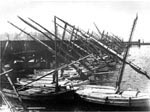
Amid the dramatic transformations of the San Francisco waterfront in recent years, one classic San Francisco locale has resisted change: Fisherman’s Wharf. The primary tourist attraction of the city, with its rows of colorful street vendors, seafood restaurants and sport fishing boats, seems a timeless fixture of the waterfront landscape.
History, however, tells another story. From the earliest days of the San Francisco waterfront, Fisherman’s Wharf has been evolving. Both its location and its layout were shifted repeatedly between 1870 and 1930 to make way for the almost constant construction of the city’s shipping wharves and seawalls. The boats that lined Fisherman’s Wharf also changed, reflecting the dynamic nature of the San Francisco Bay fisheries. Fortunately, the one thing about Fisherman’s Wharf that has remained constant is its picturesque allure. Hundreds of photographs of Fisherman’s Wharf from all its different eras survive today and provide a valuable chronicle of its transformation.
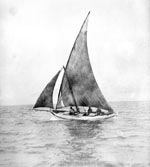 Commercial fishing along the waterfront grew with the burgeoning city of San Francisco. From the days of the Gold Rush, the city’s markets and restaurants have been supplied with fresh seafood by a growing hodgepodge of boats and newly-arrived fishermen from around the world.
Commercial fishing along the waterfront grew with the burgeoning city of San Francisco. From the days of the Gold Rush, the city’s markets and restaurants have been supplied with fresh seafood by a growing hodgepodge of boats and newly-arrived fishermen from around the world.
As early as 1856, a small village of Chinese immigrants along the southern waterfront provided for themselves and Chinatown’s fish markets using sampans and small junks built at the water’s edge. European immigrants and Americans from the East Coast pursued salmon, flounder, crabs and herring using a panoply of small boats such as sloops, whitehalls, sailing smacks and modified ships’ boats.
By the late 1860s, successive waves of Italian immigration brought hundreds of fishermen from the coastal villages near the city of Genoa into San Francisco. They also built fishing boats in the tradition of their native land, called “silenas” by the fishermen, but later more widely known as “San Francisco feluccas.” The seaworthiness of these small, lateen-rigged vessels was a perfect match for the rugged waters of the San Francisco Bay and contributed to the success of their skilled owners. The felucca quickly became the principal vessel in the fishing fleets moored along the San Francisco waterfront.
 The earliest recorded site of the growing fleet of feluccas was located at the India Dock at the foot of Vallejo and Green Streets. Here, in the inside basin of a small rectangular pier, the fleet shared pier space with a variety of larger vessels. With the practice of photography still in its nascence, there are only a few existing images of this multi-use wharf, and all of these were taken from far enough away to obscure the details of the fleet tucked in behind its sheltering piles. Not until after 1884, the year the fleet was moved to the new state-owned wharves at the foot of Union and Greenwich streets, are the familiar views of fishermen gathered together on their boats mending nets and drying sails captured on film.
The earliest recorded site of the growing fleet of feluccas was located at the India Dock at the foot of Vallejo and Green Streets. Here, in the inside basin of a small rectangular pier, the fleet shared pier space with a variety of larger vessels. With the practice of photography still in its nascence, there are only a few existing images of this multi-use wharf, and all of these were taken from far enough away to obscure the details of the fleet tucked in behind its sheltering piles. Not until after 1884, the year the fleet was moved to the new state-owned wharves at the foot of Union and Greenwich streets, are the familiar views of fishermen gathered together on their boats mending nets and drying sails captured on film.
1884-1900

As the first wharf built specifically for the fishing fleets, the Union Street Wharf was an impressive all-service facility. Jutting out from the shore on a north by northeast angle, the new Union Street Wharf comprised a long narrow rectangle about 450 feet long and 150 feet wide, with an entrance along the leeward eastern side. The easternmost pier featured a long shed for maintenance of fishing equipment, including four large boiling vats for tanning nets and sails. Tucked into the northwest corner of the wharf was a small boat slip, or ramp, which, combined with the davits lining the outboard face of the wharf, allowed the fishermen to haul out their boats for painting and repairs. Along the inshore pier, and facing the Embarcadero (then called East Street) was the Market House, where the daily catch of fish and crabs was deposited and sold in the early morning hours for resale by fish markets, hotels, restaurants and street vendors.
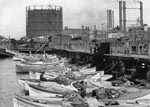 Photographs of the Union Street Fisherman’s Wharf are laden with images of the famed lateen-rigged San Francisco feluccas. These workhorses featured a mast that angled, or raked, forward sharply, and a large triangular sail hanging down from a long, two-piece yard. Some of the images of the wharf also include larger feluccas, sporting a long arching bowsprit. These are probably the offshore trawling feluccas, whose enterprising Sicilian owners introduced the efficient paranzella drag net to the Bay in 1876, and who quickly cornered the offshore rockfish market. The other feluccas fished using handlines, gillnets and, on some of the smaller feluccas, circular crabnets. Salmon, rockfish, herring and crab were their principal catches.
Photographs of the Union Street Fisherman’s Wharf are laden with images of the famed lateen-rigged San Francisco feluccas. These workhorses featured a mast that angled, or raked, forward sharply, and a large triangular sail hanging down from a long, two-piece yard. Some of the images of the wharf also include larger feluccas, sporting a long arching bowsprit. These are probably the offshore trawling feluccas, whose enterprising Sicilian owners introduced the efficient paranzella drag net to the Bay in 1876, and who quickly cornered the offshore rockfish market. The other feluccas fished using handlines, gillnets and, on some of the smaller feluccas, circular crabnets. Salmon, rockfish, herring and crab were their principal catches.
Sprinkled in among the raking masts of the feluccas along the Union Street Wharf is the occasional straight mast, landed below into the open cockpit of a sailing gillnet boat. These double-ended, spritsail-rigged, centerboard fishing boats were used primarily in salmon fisheries to lay the long tennis net-like drift nets in broad stretches across the shallower reaches of the San Pablo and San Francisco Bays, and the Sacramento and San Joaquin Rivers. In San Francisco, they were also used as tenders to the paranzella feluccas, running the catch in from outside the Golden Gate while the feluccas stayed on for another three-hour drag of the paranzella nets.
 The careful observer of the Union Street Wharf photographs may be able to distinguish a different type of boat peeking out from the shadows beneath the piers. There, with masts shipped, the fishermen moored the sailing crab boat – a small, decked sailing and rowing boat fifteen feet in length. These featured a spritsail rig and a loose-footed jib flown from a short bowsprit. The crab boats were small enough to allow easy handling among the treacherous rocky shorelines of the Bay where the crab thrived. Though the crab boat fleet numbered close to fifty boats in the 1880s, photographs of these vessels outside of their shadowy moorings are rare, a fact that has kept the type shrouded in obscurity despite its central role.
The careful observer of the Union Street Wharf photographs may be able to distinguish a different type of boat peeking out from the shadows beneath the piers. There, with masts shipped, the fishermen moored the sailing crab boat – a small, decked sailing and rowing boat fifteen feet in length. These featured a spritsail rig and a loose-footed jib flown from a short bowsprit. The crab boats were small enough to allow easy handling among the treacherous rocky shorelines of the Bay where the crab thrived. Though the crab boat fleet numbered close to fifty boats in the 1880s, photographs of these vessels outside of their shadowy moorings are rare, a fact that has kept the type shrouded in obscurity despite its central role.
1900-1915
In 1900, the continued construction of the new seawall and the booming shipping industry of San Francisco forced the fishing fleet to move again. The new Fisherman’s Wharf was located at the westernmost extension of the seawall, at the intersection of Jefferson and Taylor streets. Its long and rectangular shape mirrored the Union Street wharf. Its orientation was westward, however, and its entrance on the westward side open to San Francisco’s roaring westerly winds. The rock seawall just outside the new wharf’s entrance and along its northern edge served to break the Bay wind and protected the fleet of little boats moored behind its pilings.
 The infamous old Market House did not move with the boats to the new locale. A new one was constructed, as was a new net tanning shed. A larger ramp angled down into the water from the boat shop along the easternmost edge of the wharf. The ornate Victorian U.S. Army Barge office also shared the Taylor Street wharf and was positioned out towards the offshore end of the seawall. Two boat-building shops occupied the banks of the interior basin, soon to become the westernmost extension of Jefferson Street.
The infamous old Market House did not move with the boats to the new locale. A new one was constructed, as was a new net tanning shed. A larger ramp angled down into the water from the boat shop along the easternmost edge of the wharf. The ornate Victorian U.S. Army Barge office also shared the Taylor Street wharf and was positioned out towards the offshore end of the seawall. Two boat-building shops occupied the banks of the interior basin, soon to become the westernmost extension of Jefferson Street.
 While photographs of the wharf in its early days along Jefferson Street still feature some superb images of the steadfast feluccas and hardy sailing gillnetters, there are subtle indications of irrevocable change. Gone for instance are the sailing crab boats. By this time, the marine engine was beginning to replace the traditional sailing rigs of the fishing fleet, and new hull shapes were introduced to accommodate the weight and the drive of the engines. The little sprit-rigged crab boats were the first to disappear, replaced by a small but attractive fleet of fantail, plumb-stemmed gasoline launches. The profits made from the paranzella fishery were reinvested in a fleet of large steam tugs, whose power and efficiency far outweighed that of the large sailing feluccas, thus further securing the offshore dragnet fishery for their owners. Feluccas without masts, with cutaway sterns and propellers rising out of the water, also began to appear at the turn of the century, poignant illustrations of the desire to adapt to new technologies while holding on as much as possible to time-tested traditions.
While photographs of the wharf in its early days along Jefferson Street still feature some superb images of the steadfast feluccas and hardy sailing gillnetters, there are subtle indications of irrevocable change. Gone for instance are the sailing crab boats. By this time, the marine engine was beginning to replace the traditional sailing rigs of the fishing fleet, and new hull shapes were introduced to accommodate the weight and the drive of the engines. The little sprit-rigged crab boats were the first to disappear, replaced by a small but attractive fleet of fantail, plumb-stemmed gasoline launches. The profits made from the paranzella fishery were reinvested in a fleet of large steam tugs, whose power and efficiency far outweighed that of the large sailing feluccas, thus further securing the offshore dragnet fishery for their owners. Feluccas without masts, with cutaway sterns and propellers rising out of the water, also began to appear at the turn of the century, poignant illustrations of the desire to adapt to new technologies while holding on as much as possible to time-tested traditions.
1915-1930
By 1930 the marine engine had completely taken hold of Fisherman’s Wharf. The universality of its acceptance by then is reflected in the uniformity of vessel types along the wharf.
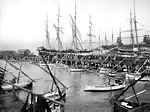 The clipper-bowed Monterey fishing boats were ubiquitous. Their bluff sterns countered the tendency of vessels to squat under the drive and the weight of the engine; their dramatically rising, hollow-sectioned clipper bows proved perfect for driving through waves under power; and their small amidship wheelhouses provided protection on longer journeys into the deeper, rougher waters of the Bay. These traits assured their popularity as a universal, multi-purpose vessel, used in all the fisheries for trawling, trolling, crabbing and gillnetting.
The clipper-bowed Monterey fishing boats were ubiquitous. Their bluff sterns countered the tendency of vessels to squat under the drive and the weight of the engine; their dramatically rising, hollow-sectioned clipper bows proved perfect for driving through waves under power; and their small amidship wheelhouses provided protection on longer journeys into the deeper, rougher waters of the Bay. These traits assured their popularity as a universal, multi-purpose vessel, used in all the fisheries for trawling, trolling, crabbing and gillnetting.
Their efficiency and the increased efficiency of distribution networks encouraged a boom for the fisheries held in check only by the ravages of the Great Depression. The products of the Bay were transported from the piers of San Francisco’s Fisherman’s Wharf by truck, rail, and ship throughout the West Coast and the rest of country. Many of the traditional marketing facilities of the older Fisherman’s Wharf, such as the Fish Market building, were replaced by industrial processing and packing facilities.
 To accommodate the new facilities of the 1920s and 1930s, Fisherman’s Wharf was enlarged into three basins, with Jones Street filled in along what once was the protective riprap at the Western opening of the original basin. The old Southern pier extended all the way to the new Jones Street, requiring the Montereys to travel under the pier. Thus many of the vessels during this period feature hinged, or tabernacle, masts, that they would drop to pass under the pier. To accommodate the heavier Montereys, the light ramps of the Fisherman’s Wharves of the past were abandoned in favor of a large, heavily constructed boat skid leading right up to the boat-building shops of Castagnola, Labruzzi and Genoa, and the machine shop of Boicelli and Boss. Here the Montereys were built and repaired, and their dependable, single-cylinder marine engines serviced, insuring the longevity and productivity of the hardworking fleet.
To accommodate the new facilities of the 1920s and 1930s, Fisherman’s Wharf was enlarged into three basins, with Jones Street filled in along what once was the protective riprap at the Western opening of the original basin. The old Southern pier extended all the way to the new Jones Street, requiring the Montereys to travel under the pier. Thus many of the vessels during this period feature hinged, or tabernacle, masts, that they would drop to pass under the pier. To accommodate the heavier Montereys, the light ramps of the Fisherman’s Wharves of the past were abandoned in favor of a large, heavily constructed boat skid leading right up to the boat-building shops of Castagnola, Labruzzi and Genoa, and the machine shop of Boicelli and Boss. Here the Montereys were built and repaired, and their dependable, single-cylinder marine engines serviced, insuring the longevity and productivity of the hardworking fleet.
 From the 1930s until now, still further changes have affected our Fisherman’s Wharf. Many of the names involved in the fisheries then, such as Castagnola, Tarantino and Alioto are still present, having traded in the tenuous fortunes of the fisherman’s life for the steadier, more lucrative fish distribution and restaurant businesses. New waves of immigration have brought Southeast Asian fishermen to our wharves, fishing to supply the live fish markets of Chinatown and the Tenderloin. Sport fishing boats and tour boats now vie for space with the local commercial fishing fleets, while these in turn shift and jostle to make room pierside for visiting vessels of the transient herring and salmon fleets of the Pacific Coast. Even today, piles are being driven to expand the docking space for these industrious fleets, and new state-of-the-art processing and packing facilities are being constructed.
From the 1930s until now, still further changes have affected our Fisherman’s Wharf. Many of the names involved in the fisheries then, such as Castagnola, Tarantino and Alioto are still present, having traded in the tenuous fortunes of the fisherman’s life for the steadier, more lucrative fish distribution and restaurant businesses. New waves of immigration have brought Southeast Asian fishermen to our wharves, fishing to supply the live fish markets of Chinatown and the Tenderloin. Sport fishing boats and tour boats now vie for space with the local commercial fishing fleets, while these in turn shift and jostle to make room pierside for visiting vessels of the transient herring and salmon fleets of the Pacific Coast. Even today, piles are being driven to expand the docking space for these industrious fleets, and new state-of-the-art processing and packing facilities are being constructed.
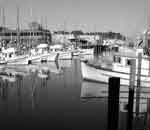 As Fisherman’s Wharf continues its long tradition of change, traces of its past remain. Many of the structures and some of the boats that played such a central role in San Francisco’s fishing community of the early twentieth century can still be seen along the waterfront. These provide a tangible and moving connection between the past and the present chapters of the dynamic story of Fisherman’s Wharf.
As Fisherman’s Wharf continues its long tradition of change, traces of its past remain. Many of the structures and some of the boats that played such a central role in San Francisco’s fishing community of the early twentieth century can still be seen along the waterfront. These provide a tangible and moving connection between the past and the present chapters of the dynamic story of Fisherman’s Wharf.
Tides of Change: Fisherman’s Wharf, 1870-1930, is reprinted with permission from the San Francisco Maritime National Park Association’s history publication Sea Letter.
Photos with call numbers are printed from the Park’s collection. Current photos are by Park photographers Tim Campbell and Steve Danford.
John C. Muir is Associate Curator of Small Craft at the Park.
Categorised in: Yachting and sailing stories
This post was written by christoforos
